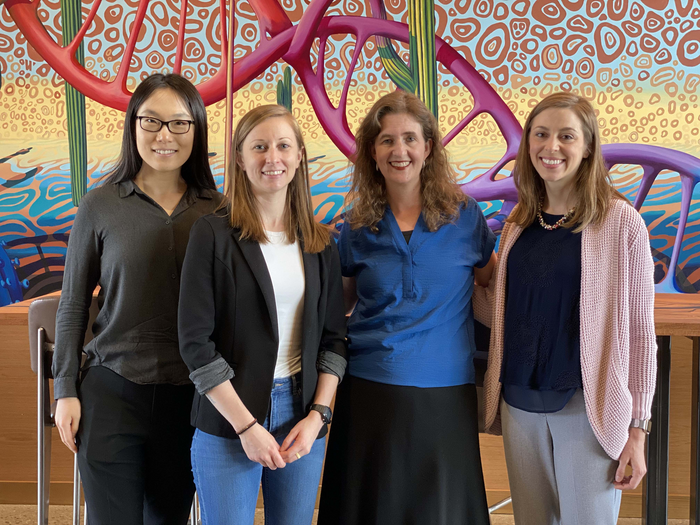Tempe, Ariz. – Research conducted by scientists at Arizona State University reveals the power of wastewater-based epidemiology to assess the dietary behavior of discrete populations—even neighborhood St. Patrick’s Day celebrations. The results, published today (March 13, 2023) in the journal Nature Food, could enable more effective, targeted measures to improve public health.

Credit: Arizona State University
Tempe, Ariz. – Research conducted by scientists at Arizona State University reveals the power of wastewater-based epidemiology to assess the dietary behavior of discrete populations—even neighborhood St. Patrick’s Day celebrations. The results, published today (March 13, 2023) in the journal Nature Food, could enable more effective, targeted measures to improve public health.
For seven consecutive days each month over a period of two years—August 2017 to July 2019—a team of ASU scientists collected composited daily samples from a sewer catchment serving a small residential district of Tempe, Arizona. Using those samples, they identified and measured levels of major phytoestrogens and byproducts linked to plant-based food consumption.
“In doing so, we demonstrated the ability to monitor indicators of diet and see trends in dietary behavior,” said Devin Bowes, who helped lead the study during her doctoral work in biological design at ASU. “For example, at the beginning of each year during this study, we saw huge spikes in phytoestrogen levels that strongly suggest behavioral change along the lines of New Year’s resolutions to eat healthier foods.”
They also established the ability to detect microbes from the human gut that indicate dietary behavior as well as sudden changes in that behavior—such as surges in alcohol consumption.
“We saw a giant spike in the production of the human gut metabolite equol during mid-March of 2019,” said Bowes, now a postdoctoral associate at Boston University. “It was a peculiar finding, but then we found studies showing acute alcohol consumption in large amounts leads to greater production of equol. Of course, we know that many people consume alcohol during the St. Patrick’s holiday, but we wanted to confirm that link by measuring the alcohol metabolite ethyl sulfate.”
They did so and the result stood out like a four-leaf clover: ethyl sulfate increased at the same rate as equol on the same day: St. Patrick’s Day.
Bowes said the contextual nature of this investigation is important. The study is not a sweeping overview of the nation, but a snapshot of a residential community with fewer than 10,000 people. This narrow focus enables detailed understanding of dietary behavior.
“For example, we know from existing data that people in the United States consume on average between one to three milligrams of phytoestrogens per day,” Bowes said. “But in this study, average consumption over the two years was four to five milligrams per day. That’s a big difference, so we wanted to dig deeper to find out why.”
Bowes said those larger numbers were driven predominantly by isoflavonoid consumption, which is a subset of phytoestrogens predominantly from soy or soy-based foods. Additionally, demographic distributions reported for this small community revealed a significantly higher percentage of Asian residents (25%) versus the United States as a whole (5%).
“And we know from scientific literature that Asian populations tend to consume high amounts of isoflavones or soy-based products. It’s reported between 25 to 50 milligrams per day,” Bowes said. “Consequently, this specific result demonstrates that we can use these methods to get very accurate and contextualized dietary measurements of populations.”
Bowes is enthusiastic about the potential of wastewater-based epidemiology to assess intervention efficacy. She suggested lunch programs at even single schools as an example.
“Let’s say they want to implement Meatless Mondays,” Bowes said. “A wastewater monitoring program could offer nearly real-time measurement of the impact of that change. They also could add other biomarkers that can indicate the presence of nutrition-related chronic diseases so health professionals could customize how they intervene.”
Rosa Krajmalnik-Brown, a professor of environmental engineering in ASU’s Ira A. Fulton Schools of Engineering, as well as director of the ASU Biodesign Institute’s Center for Health Through Microbiomes and a co-author of the paper, said this study represents an important proof of concept offering substantial opportunities for understanding and improving public health.
“Wastewater-based epidemiology has been used extensively to monitor incidence of COVID-19. But we are now discovering so much about the human gut microbiome that we could use a similar approach with microbes to determine signatures of diet and what they can tell us about communities,” she said. “As we look to the future, microbial assessment could help us to identify and serve populations that are experiencing, for example, traumatic conditions. There really are amazing possibilities to consider.”
Other contributors to the paper—Integrated multiomic wastewater-based epidemiology can elucidate population-level dietary behaviour and inform public health nutrition assessments—include corresponding author Rolf Halden, Erin Driver, Sonja Savic, Qiwen Cheng and Corrie Whisner. Funding for the study was provided by the Virginia G. Piper Charitable Trust.
# # #
Journal
Nature Food
DOI
10.1038/s43016-023-00717-w
Method of Research
Experimental study
Subject of Research
Not applicable
Article Title
Integrated multiomic wastewater-based epidemiology can elucidate population-level dietary behaviour and inform public health nutrition assessments
Article Publication Date
13-Mar-2023
COI Statement
EMD is a managing member of AquaVitas, LLC, a company working in the field of wastewater-based epidemiology. RUH is a managing member of AquaVitas LLC and of the non-profit project OneWaterOneHealth of the Arizona State University Foundation, with both entities being involved in the same intellectual space. The remaining authors declare no competing interests.




